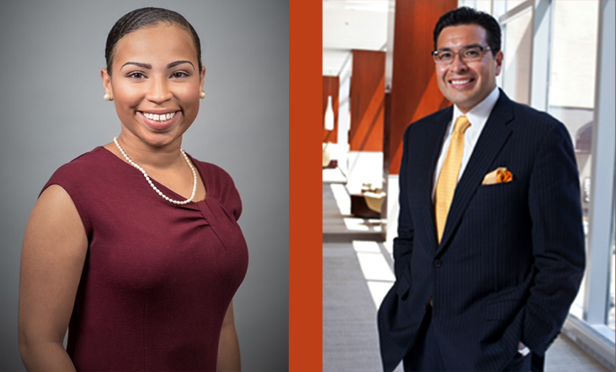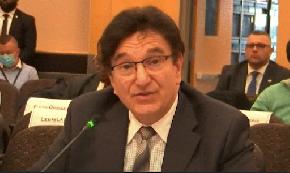 Sylvester: “It’s in an owner’s best interest to ask the management organization about the diversity programs and keep track of those programs.”
Sylvester: “It’s in an owner’s best interest to ask the management organization about the diversity programs and keep track of those programs.”
Rodriguez: “If young, diverse professionals and women don’t see people like themselves in senior leadership roles, they’ll question whether a career in commercial real estate is a smart move for them.”
CHICAGO–We’ve all read the statistics. Commercial real estate is an aging practice. In fact, the average age of just one segment—property management—is well into the 50s. The perpetuation of the profession is very much at stake here, but there are cures on the horizon, one in particular that can lend additional thought leadership to the practice while ensuring succession…namely a greater focus on diversity.
That message will be made loud and clear at the upcoming Global Summit of the Institute of Real Estate Management (IREM), slated for September 26 through the 29th in Hollywood, FL. “Diversity 2.0: Moving from Rhetoric to Action” will be the platform for that message.
Two of the panelists, Robert Rodriguez, Ph.D, president of DRR Advisors LLC in Chicago; and Jasmyn Sylvester, ACoM, a portfolio manager at the Shopping Center Group in Jacksonville, FL, sat down with GlobeSt.com to discuss the importance of diversity strategies in the commercial real estate space.
For the record, Sylvester is also a 2018 IREM diversity scholar, which allows her to serve on the group’s Diversity Advisory Board. She is also her chapter’s liaison for the IREM Historically Black College & University Task Force.
GlobeSt.com: Is commercial real estate behind the diversity curve?
Robert Rodriguez: I wouldn’t say that commercial real estate is behind other industries. But the commitment to Diversity & Inclusion is a well-kept secret. While many companies, and industries, have an opportunity to elevate their commitment to D&I, most outside of commercial real estate don’t consider the industry as a leader in this area. Doing a better job of highlighting that commitment and success stories will go a long way to changing the perception of commercial real estate as behind the times.
Jasmyn Sylvester: I have certainly seen first-hand what navigating this industry is like for people in under-represented groups, as I am one of those individuals. We’re talking about a systemic issue, one that ultimately we would have to take a time machine to repair completely. In comparison to other industries, I can say we are still slightly behind the curve with regard to diversity. But we have taken strides in terms of bringing awareness.
GlobeSt.com: So, Jasmyn, what’s the mission of the Diversity Advisory Board and how does it define diversity?
Sylvester: The committee was created to add additional support to our members of under-represented groups and help them advance in their careers. We provide resources to help them with career development–like the diversity scholar program which recognizes IREM members who have an interest in becoming industry leaders. We’ve also developed the HBCU Taskforce, which we aim to introduce students to real estate management.
In terms of definitions, there are many aspects that encompass diversity. You have generational, cultural and socio-economic diversity as well as gender and LGBT diversity. All of these make up our view of diversity within our industry.
GlobeSt.com: For the record, let’s discuss how a diversity strategy can increase a pool of talent and help a firm reach multicultural markets.
Rodriguez: The marketplace generally and commercial real estate consumers in particular are becoming more diverse. Companies absolutely need an employee profile that mirrors their client base. Without talent from multicultural backgrounds, it’s more difficult to reach those markets. A diversity strategy can help ensure that an organization is selecting top talent from a much broader talent pool. A diversity strategy can also help an organization reduce unconscious bias during the interview process and minimize the possibility of overlooking diverse candidates. And it allows women and minorities to bring their whole selves to work and therefore are much more likely to serve as authentic leaders.
Sylvester: I agree. Employing a diversity strategy ultimately broadens an organization’s reach. You’ll miss the mark every single time when you use the same tactics over and over again. An organization has to ensure its makeup is reflective of its clients and the community it serves.
Also, multicultural representation can take a company from a local platform to as far as a global market. Establishing D & I Programs may allow an organization to leverage business profitability. That should be appealing to industry executives. Diversity at the decision table provides space for innovation and a fresh perspective. And it will attract diverse talent.
GlobeSt.com: Robert, what exactly is the 4C Model, and how in practical terms does that help an organization achieve a diverse culture?
Rodriguez: The 4C Model is simply a strategic framework for diversity and inclusion initiatives. Its general philosophy is that anything an organization does related to diversity can fall into one of four segments: Community outreach and social-responsibility efforts; Commerce, which means initiatives that have a direct link to business outcomes; Culture, or efforts aimed at elevating the cultural competency of a firm; and Career, programs that enhance recruitment, retention and advancement.
By dividing diversity initiatives into these categories, a company can more effectively prioritize diversity efforts that are more pressing. Also, it can help determine gaps that need additional attention. For example, if a company’s diversity efforts focus primarily on culture and career initiatives, it could lessen the acceptance of diversity initiatives because there’s no clear link to business goals.
GlobeSt.com: Jasmyn, what do you see a company doing to increase its diversity initiatives?
Sylvester: The first step is to assess the current culture and climate within the workplace. A company will then have to make adjustments accordingly, and talent retention should be a company’s first priority. The cost of employee turnover can be catastrophic. How is the firm keeping the existing employees and how does it create an inclusive environment? Diversity is about fostering a space where someone can bring their authentic self to work without distress or reservation.
A person holds a lot back when they’re “the only,” fearful of what others might perceive of ones differences. That in itself is a heavy burden to bear, and it brings less focus to what one is there for, which is the business and to be productive. Those of under-represented groups are less likely to stay in an isolating environment, so that would be Step One.
Step Two is being creative about hiring practices. Companies should list their job postings in a variety of platforms, analyze job descriptions and how they’re created. Many communities have organizations for under-represented groups, which can be a resource for talent recruitment and a great starting point for getting the word out about an opening. A company could miss out on the opportunity to welcome a superstar into their organization.
GlobeSt.com: Let’s move from management to their clients: owners and investors.
Sylvester: It’s in an owner’s best interest to ask the management organization about the diversity programs and keep track of those programs. Are there training resources for those performing interviews? Once the HR department is trained, they’ve gone through the recruitment process and a new employee is hired, how are they then following along? That’s where sponsorships and mentorships are important for leadership development. Maybe pairing that new hire with a seasoned professional, to make sure that talent is being cultivated.
Rodriguez: If a management organization doesn’t have an established diversity strategy, there might be some concerns about their commitment to diversity. Another approach is to ask for a breakdown of the management organization’s leadership team by race, ethnicity and gender. If there’s little to no gender or racial/ethnic diversity on the leadership team, a building owner may want to ask to hear more about their diversity programs and initiatives.
Jasmyn mentioned an inclusive environment before. To that point, employee resource groups are groups of employees who join together in their workplace based on shared characteristics, life experiences and historically underrepresented groups. For instance, a Women’s ERG can help provide insights on common career challenges faced by women at an organization and develop recommendations on how to resolve those issues. A Latino ERG can provide cultural insights into Hispanic heritage and Latino culture. Such insights could be extremely valuable for real estate professionals looking to build stronger relationships within Latino communities. And an LGBT ERG can help an organization make inroads on how to best establish relationships with building owners in neighborhoods that cater to a predominantly gay and lesbian community.
There is a saying: “You can’t be what you can’t see.” If young, diverse professionals and women don’t see people like themselves in senior leadership roles, they’ll question whether a career in commercial real estate is a smart move for them. No woman or minority wants to be labeled as the token representative for a diverse group. But highlighting such individuals does convey that making sure certain communities are represented is important. It’s a slight nuance, but significant nonetheless.

















 Copyright © 2024 ALM Global, LLC. All Rights Reserved.
Copyright © 2024 ALM Global, LLC. All Rights Reserved.